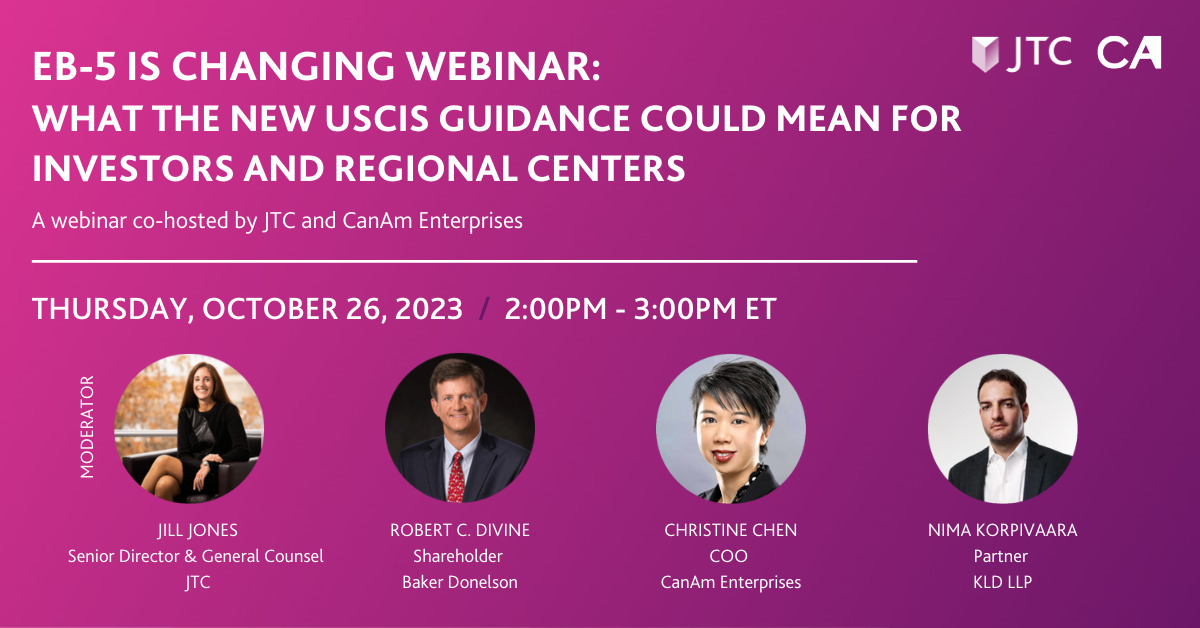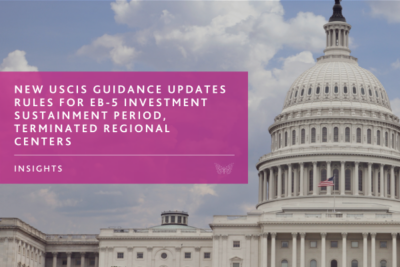Any discussion regarding the EB-5 industry these days inevitably includes the words “retrogression,” “backlog,” and “long processing times.” And for good reason. Although USCIS’ published adjudication time for the conditional green card petition is now between 29 and 45.5 months, due to visa backlogs, the actual wait time to obtain an EB-5 visa is much longer. For Mainland born Chinese nationals who file an I-526 Petition today, it may take as long as 16 years to receive a green card. The backlog is not exclusive to China. Vietnam joined the list last year and most recently, India joined as well. It is predicted that South Korea, Taiwan and Brazil are next.
With the general lack of guidance, other than what we saw in the June 2017 Policy Memorandum, on redeployment from USCIS, many investors who are in the queue for visa availability are considering whether it is worth it to have their funds redeployed in order to continue pursuing an EB-5 visa. The specific reasons investors may opt to withdraw vary among individual investors but often hinge on whether their children may “age out” and no longer qualify as derivative beneficiaries at the time the EB-5 visas become available, or simply general frustration that wait times are too long with no signs of a clear outcome. Foreign nationals who have made the decision to uproot their families and relocate to the U.S. are averse to such uncertainty in the immigration process, particularly immigrant investors who, in addition to immigration risks, also expose their capital to market risks in order to comply with EB-5 Program requirements.
In addition to the hardships imposed on the EB-5 investors, the EB-5 backlog can also negatively impact regional centers and real estate project developers who have raised EB-5 capital over the years.
Tom Rosenfeld, President and CEO at CanAm Enterprises, a leading regional center operator that has been active in the EB-5 industry for more than 15 years, agrees: “The visa backlog is currently the main drawback of the EB-5 Program for all parties involved, from investors and regional centers to project developers. We need visa relief to make the EB-5 Program viable for the long-term. Prioritizing legislative changes that afford visa relief is imperative for all EB-5 stakeholders.”
It seems that since May 2015, when retrogression first impacted Mainland born Chinese investors, we have been discussing how to get more visas allocated to the EB-5 Program. Similar to many industries, legislative relief lags behind the demands of the market. Several Senators have brought backlog issues to the attention of fellow congressional representatives, with Senator Rand Paul (R-KY) being among the most vocal proponents of the EB-5 Program and particularly, visa backlog relief. There are some possible changes on the horizon that could give hope to the thousands of backlogged EB-5 investors.
The first question is, could a couple of thousand extra visas really make a difference? The USCIS reported for the third quarter of fiscal year 2019 that there are 13,070 petitions awaiting adjudication. And with the rush of filings leading up to the November 21, 2019 effective date of the EB-5 Immigrant Investor Program Modernization, we expect that number to be much higher today.
According to an analysis by Suzanne Lazicki, Founder and President at Lucid Professional Writing, investors from countries that exhaust their annual quota of visas leaving a backlog of investors to wait for a new batch of visas to be allocated (namely China, Vietnam and India), a reallocation of 1,500 visas from the diversity visa category could decrease expected visa wait times for EB-5 by up to 15%. Because the current backlog is so heavily dominated by Mainland born Chinese investors 1,500 visas added to the worldwide quota could result in up to 1,290 additional visas for China (a 25% increase over current expectations).
In addition to the wait time improvements, even a small increase in visa capacity could have a significant positive impact on US job creation. “Having only 1,500 extra visas available to investors can still have a meaningful impact on job creation,” said Reid Thomas, EVP of NES Financial, a Specialty Financial Administrator which serves sectors characterized by high administrative complexity, increased transaction security needs, and challenging regulatory compliance requirements, including EB-5. “The U.S. Dept. of Commerce released a study in 2013 that reported on the job creation by the EB-5 program,” added Thomas. “According to those statistics, an extra 1,500 visas would translate to about 8,000 permanent U.S. jobs.”
“Given that the US welcomes well over a million new permanent residents annually, an additional 1,500 visas (less than on quarter of one percent) to create 8,000 new jobs seems like a relatively small ask,” said Robert Divine, an attorney and leader of Baker Donelson’s Global Immigration Group and former Chief Counsel of USCIS.
Proposed Changes that May Move the Needle on the EB-5 Backlog
- EB-5 “modernization” may reduce the number and pace of new applications filed
On November 21, 2019, new regulations that will make material changes to the EB-5 Program became effective. In particular, the new regulations provide for an increase in the minimum investment amount from $500,000 for projects located in Target Employment Areas (TEAs) to $900,00, and from $1,000,000 for projects outside of TEAs to $1,800,000. This higher investment threshold is likely to create a pause in demand for EB-5 visas as new investors seeking permanent residency abroad consider whether the United States EB-5 program is the right fit, or whether permanent residency in another country would better meet their needs. During this pause, any unused visas will be made available to retrogressed investors who have been waiting for an EB-5 visa to become available. As such, the implementation of new regulations may actually help decrease the wait times for backlogged investors.
- Not counting derivative beneficiaries toward the annual EB-5 visa limit
Many have argued that when Congress originally authorized the EB-5 Program, it intended to admit 10,000 investor familiesannually and not 10,000 individuals which includes the principal investors plus their derivative family members, which is the current visa-allocation system.
It has been suggested that the original intent of Congress was to create 100,000 jobs per year through the EB-5 program (i.e., 10 jobs per 10,000 visas). This provides a strong foundation for the appeal to exempt derivative family members from the annual EB-5 visa allocation.
Bernard Wolfsdorf, Managing Partner at Wolfsdorf Rosenthal LLP, shares similar views: “Because each I-526 petition results in an average of about three visas, eliminating derivatives from counting against the annual limit of available EB-5 visas would shorten the backlog by approximately two-thirds. Fortunately, Senate Judiciary Committee Chairman Lindsey O. Graham (R-S.C.) has been working with Sens. Mike Rounds (R-S.D.) and John Cornyn (R-Tex.) on a proposal that will resolve this issue by clarifying the original intent of admitting 10,000 investors, not about 3,000 investors and their families.”
- Recover unused visas from prior fiscal years
Another idea that has drawn attention is to recapture unused visas from prior years. While all available EB-5 visas have been used annually since 2014, prior to that year, a substantial number of EB-5 visas went unused. If past unused visa numbers are recaptured, the backlog could be potentially eliminated without adding any new visa numbers.
- Reallocating visa numbers from other visa categories
When trying to solve the EB-5 backlog, it has been proposed to “borrow” visa numbers from other categories, such as the lottery-based diversity visa category, or from other underutilized employment-based visa categories, in order to prioritize the economic benefits of the EB-5 program. This notion is grounded in past acts of Congress. In 1989 unused family visas were reallocated to the employment visa categories. Of course, advocates of this proposal face opposition from other immigration stakeholders who may experience less visa availability following such a reallocation.
Nobody likes losing, especially not the U.S. economy
The EB-5 visa backlog has become so significant that it has garnered the attention of legislators who have expressed concern over the potential loss of foreign investment in the United States economy and the impact on American jobs. Leon Rodriguez, Partner at Seyfarth Shaw LLP and the former Director of USCIS, also suggests that solving the backlog is in the best interests of the American economy: “It is clear that there is strong demand for permanent residency in the United States, and unlike other visa categories, EB-5 is directly linked to job creation for American workers,” said Rodriguez. “It is in America’s own interest to resolve the backlog.”
Resolving the backlog is essential
While the exact solution to the EB-5 visa backlog is not yet clear, what matters most is to maintain the momentum that this issue has gained due to its dramatic impact on an increasing number of EB-5 investors. EB-5 retrogression has finally received meaningful attention in the Senate, and it is being actively discussed. Political proponents agree that EB-5 is beneficial to the Country’s economy and job growth.
For now, investors need to redeploy
In the meantime, until the backlog is resolved, EB-5 projects are going to reach completion, especially in the case of projects structured as five-year loans, but the investors will not be permitted to accept repayment of their funds. The issuers in these offerings are going to have to find ways to redeploy the investors’ capital in order to meet the EB-5 Program’s requirement to sustain capital at risk until the end of the two-year conditional residency period.
Viable redeployment solutions are also a debated topic among EB-5 stakeholders. Redeployment should ultimately have as its number one priority, preserving the investors’ opportunity to immigrate to the United States. Because investors are not required to create any additional jobs once the original job creation requirement has been satisfied, there is no need to redeploy to another, potentially riskier, EB-5 project investment. Investors may seek higher returns through various real estate project investments, or more measured returns through municipal bonds. Ultimately, any redeployment investment must be permitted under the governing investment documents and adhere, as closely as possible, to USCIS guidance.




